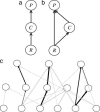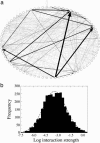Interaction strength combinations and the overfishing of a marine food web
- PMID: 15802468
- PMCID: PMC556268
- DOI: 10.1073/pnas.0501562102
Interaction strength combinations and the overfishing of a marine food web
Abstract
The stability of ecological communities largely depends on the strength of interactions between predators and their prey. Here we show that these interaction strengths are structured nonrandomly in a large Caribbean marine food web. Specifically, the cooccurrence of strong interactions on two consecutive levels of food chains occurs less frequently than expected by chance. Even when they occur, these strongly interacting chains are accompanied by strong omnivory more often than expected by chance. By using a food web model, we show that these interaction strength combinations reduce the likelihood of trophic cascades after the overfishing of top predators. However, fishing selectively removes predators that are overrepresented in strongly interacting chains. Hence, the potential for strong community-wide effects remains a threat.
Figures



References
-
- Ulanowicz, R. E. & Wolff, W. F. (1991) Math. Biosci. 103, 45–68. - PubMed
-
- Paine, R. T. (1992) Nature 355, 73–75.
-
- Fagan, W. F. & Hurd, L. E. (1994) Ecology 75, 2022–2032.
-
- Raffaelli, D. & Hall, S. (1995) in Food Webs: Integration of Patterns and Dynamics, eds. Polis, G. & Winemiller, K. (Chapman & Hall, New York), pp. 185–191.
-
- Wootton, J. T. (1997) Ecol. Monogr. 67, 45–64.
Publication types
MeSH terms
LinkOut - more resources
Full Text Sources
Other Literature Sources

